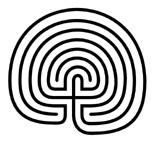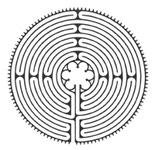Labyrinths – An Introduction
Home » Articles and News » Labyrinths – An Introduction
 A labyrinth is an ancient symbol that relates to wholeness. It combines the imagery of the circle and the spiral into a meandering but purposeful path. The Labyrinth represents a journey to our own center and back again out into the world. Labyrinths have long been used for meditation and prayer, a tool for an inward journey and self-reflection.
Mazes and a range of labyrinth designs are found all around the world in many cultures and civilizations. They are found carved in rock, ceramics, clay tablets, mosaics, manuscripts, stone patterns, turf, hedges, and cathedral pavements. The earliest known designs are about 3000 years old. The significance of them for the various cultures they were part of and the story of how they developed from one place to another (or simultaneously appeared in several) is often mysterious and hard to fathom. The most ancient and widespread design looks complicated but can be drawn quite easily if you know the method.
The labyrinth has since ancient times been associated with the legend of the Minotaur, the monster half-man half-bull which dwelt in the heart of a labyrinth on the island of Crete. Theseus was able to get to the center of the labyrinth, slay the Minotaur and find his way out again by following the thread he had trailed behind him on the way in. But the story has caused confusion ever since, because clearly the Minotaur’s lair was a maze that you could get lost in, whereas a labyrinth, however confusing it looks, has only one twisting path that weaves its way to the center and back out again. There is only one entrance and exit, no dead ends, and no crossing of paths with a choice of which way to turn.
Cathedral Labyrinths
A labyrinth is an ancient symbol that relates to wholeness. It combines the imagery of the circle and the spiral into a meandering but purposeful path. The Labyrinth represents a journey to our own center and back again out into the world. Labyrinths have long been used for meditation and prayer, a tool for an inward journey and self-reflection.
Mazes and a range of labyrinth designs are found all around the world in many cultures and civilizations. They are found carved in rock, ceramics, clay tablets, mosaics, manuscripts, stone patterns, turf, hedges, and cathedral pavements. The earliest known designs are about 3000 years old. The significance of them for the various cultures they were part of and the story of how they developed from one place to another (or simultaneously appeared in several) is often mysterious and hard to fathom. The most ancient and widespread design looks complicated but can be drawn quite easily if you know the method.
The labyrinth has since ancient times been associated with the legend of the Minotaur, the monster half-man half-bull which dwelt in the heart of a labyrinth on the island of Crete. Theseus was able to get to the center of the labyrinth, slay the Minotaur and find his way out again by following the thread he had trailed behind him on the way in. But the story has caused confusion ever since, because clearly the Minotaur’s lair was a maze that you could get lost in, whereas a labyrinth, however confusing it looks, has only one twisting path that weaves its way to the center and back out again. There is only one entrance and exit, no dead ends, and no crossing of paths with a choice of which way to turn.
Cathedral Labyrinths
 The Romans adapted the ancient labyrinth symbol as a decorative floor pattern, and the Christian artists and thinkers of early medieval times developed the Roman pattern into a new and beautiful form which was used as a feature in many medieval cathedrals. It was marked out on the floor in colored stone or tiles and usually between 10 and 40 feet in diameter. A range of designs were explored, but the pattern used at Chartres Cathedral in northern France is the archetype and perfection of all medieval labyrinths. Fortunately it has been well-preserved, and in recent times pilgrims have taken to traveling to Chartres specifically to walk it.
Whilst we cannot be exactly sure what the labyrinths were used for, they were clearly a symbol of the Christian way, representing the path of the soul through life. Medieval pilgrims re-enacted this, following the path of the labyrinth in the cathedral on their knees as a means of prayer, or to symbolize the journey to Jerusalem, or as a ritual to mark the end of a pilgrimage. People walked it on the eve of their baptism or confirmation, as an aid to contemplative prayer in Holy Week, and as an illustration both of the life of the Christian and of the life of Christ. But after medieval times the spiritual uses of labyrinths were forgotten, and they fell into disuse. Many were destroyed between the 17th and 19th centuries.
Moving through a Labyrinth changes ordinary ways of perception connecting the inner and the outer, the right brain and the left brain, the involutional and the evolutional through a series of paths that create balance and expanded perception.
How to Walk the Labyrinth
There is “no correct’ way to walk a labyrinth—the journey is a very personal one. Following the tradition of Labyrinths you walk the same path going in and coming out. When you walk the Labyrinth you meander back and forth, turning 180 degrees each time you enter a different circuit. As you shift direction you also shift your awareness from right brain to left brain, inducing receptive states of
consciousness and balancing your energy. Here are some additional suggestions:
The Romans adapted the ancient labyrinth symbol as a decorative floor pattern, and the Christian artists and thinkers of early medieval times developed the Roman pattern into a new and beautiful form which was used as a feature in many medieval cathedrals. It was marked out on the floor in colored stone or tiles and usually between 10 and 40 feet in diameter. A range of designs were explored, but the pattern used at Chartres Cathedral in northern France is the archetype and perfection of all medieval labyrinths. Fortunately it has been well-preserved, and in recent times pilgrims have taken to traveling to Chartres specifically to walk it.
Whilst we cannot be exactly sure what the labyrinths were used for, they were clearly a symbol of the Christian way, representing the path of the soul through life. Medieval pilgrims re-enacted this, following the path of the labyrinth in the cathedral on their knees as a means of prayer, or to symbolize the journey to Jerusalem, or as a ritual to mark the end of a pilgrimage. People walked it on the eve of their baptism or confirmation, as an aid to contemplative prayer in Holy Week, and as an illustration both of the life of the Christian and of the life of Christ. But after medieval times the spiritual uses of labyrinths were forgotten, and they fell into disuse. Many were destroyed between the 17th and 19th centuries.
Moving through a Labyrinth changes ordinary ways of perception connecting the inner and the outer, the right brain and the left brain, the involutional and the evolutional through a series of paths that create balance and expanded perception.
How to Walk the Labyrinth
There is “no correct’ way to walk a labyrinth—the journey is a very personal one. Following the tradition of Labyrinths you walk the same path going in and coming out. When you walk the Labyrinth you meander back and forth, turning 180 degrees each time you enter a different circuit. As you shift direction you also shift your awareness from right brain to left brain, inducing receptive states of
consciousness and balancing your energy. Here are some additional suggestions:
- Prepare to walk. Slow your breathing. Still your mind. Open yourself to the possibilities.
- Begin your journey.
- Walk the inward path. Focus on letting go of the things you want to leave behind…and release the things that stand in the way of your spiritual journey.
- Spend time in the center.
- Begin walking back the way you came. The return is as much the journey as every other part of the labyrinth.
- Reflect on the journey.
Home » Articles and News » Labyrinths – An Introduction
